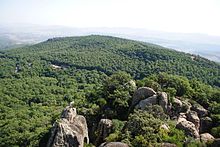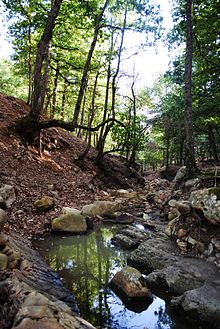El Feija National Park
The El Feija National Park, founded in 1990, is located in the northwest of Tunisia , 17 kilometers west of the city of Ghardimaou , 49 kilometers west of the provincial capital Jendouba and 195 kilometers west of the capital Tunis .
The national park , located at an altitude of between 550 and 1,150 meters, represents the natural landscape of the Kroumirie , the most humid region of Tunisia with an average annual rainfall of between 1200 and 2000 mm. Embedded in the 2,637 hectare area is a 417 hectare game reserve to protect the Berber deer (Cervus elaphus barbarus), the only endemic species of deer in Africa. The fenced-in area was set up in 1966 to protect the species, which at that time had shrunk to a few hundred specimens and was directly threatened with extinction.
Around 90 percent of the national park is covered by forest . The predominant tree species include the pine oak (Quercus faginea) and the cork oak (Quercus suber). Around 700 plant species, some of them endemic and threatened, grow under their protection. This also includes a wide variety of medicinal and aromatic plants.
The fauna of the national park is also rich in species. With the Berber deer, this includes 25 mammal species, including the golden jackal (Canis aureus), the red fox (Vulpes vulpes), the porcupine (Hystrix cristata), and the African wildcat (Felis libyca). There are also 25 species of reptiles and 70 species of birds.
Mainly due to its extraordinary biological diversity, the El Feija National Park has been on the tentative list for recognition as a UNESCO World Heritage Site since 2008 .
history
The oldest human traces go back around 10,000 years, as is evident from finds of obsidian and flint . Rock paintings and carvings on the 64 m high Rocher de Kef Negcha, from where there is a broad view of the Medjerda valley, are likely from the Neolithic .
Ruins of the Numidians , such as fortresses and trading posts , also indicate development.
The forests also contain fortifications and the remains of camps from the Algerian War dating from 1960 to 1962, including the camp of Houari Boumedienne .
Web links
- Description on the pages of UNESCO (English)
- Dossier of the El Feija National Park (UNESCO, French)
See also
Individual evidence
- ↑ UNESCO Center du patrimoine mondial: Parc National d'El Feija - UNESCO World Heritage Center. In: whc.unesco.org. Retrieved May 20, 2016 (French).
- ↑ Emile Violard: La Tunisie du Nord , Société Anonyme de l'imprimerie rapidly, Tunis 1905, p. 32
Coordinates: 36 ° 46 ′ 10.9 ″ N , 8 ° 39 ′ 10.4 ″ E

